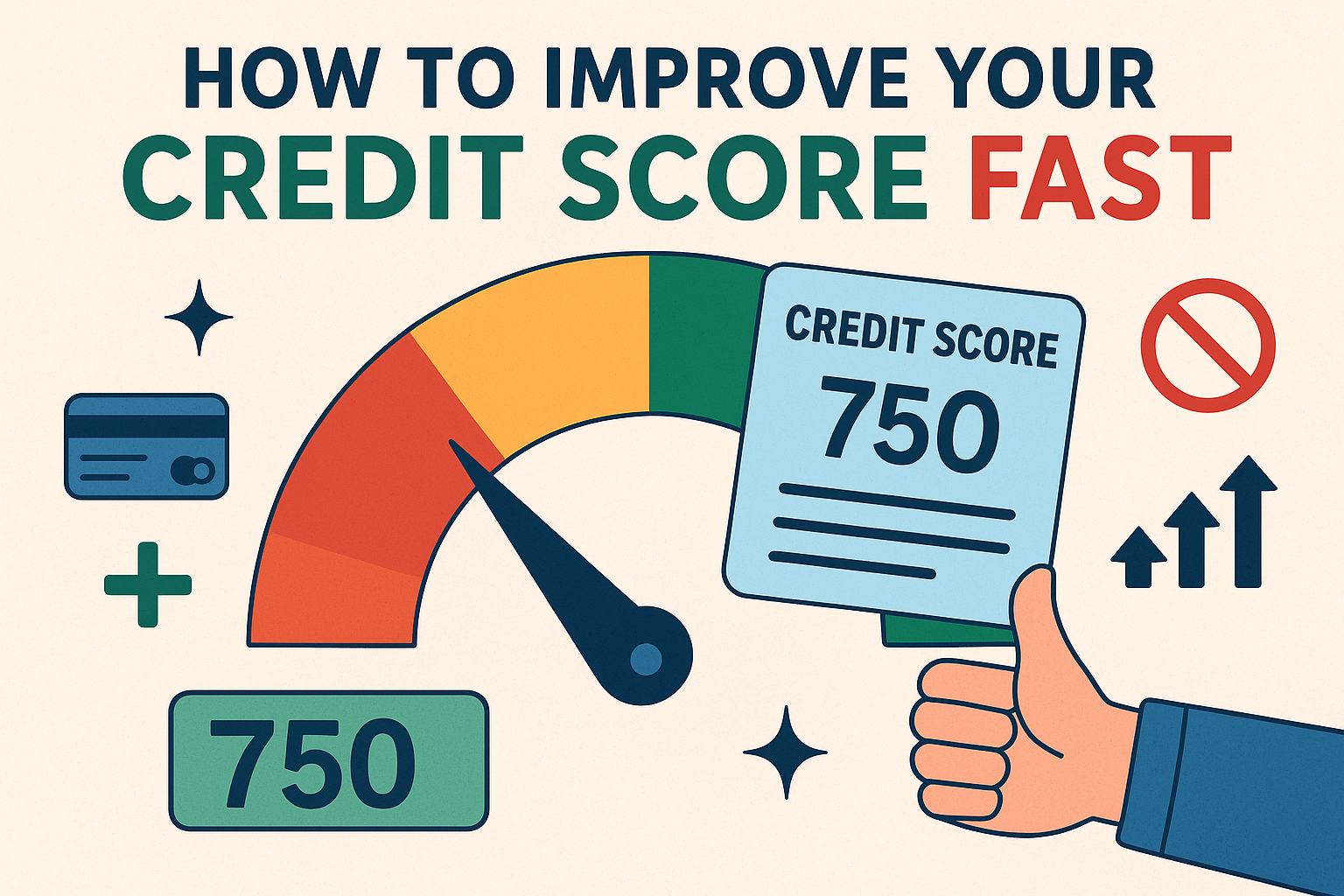Want to improve your credit score fast? You’re not alone. A higher score can lower your borrowing costs, unlock better credit cards, and even help with apartment approvals and insurance rates. The good news: you can raise your credit score quickly with a focused plan that fixes the biggest scoring factors first—payment history and credit utilization—while you clean up errors and build positive habits.
This step‑by‑step guide gives you quick wins (24–48 hours), short‑term moves (within 30–60 days), and smart long‑term strategies so your score climbs and stays high.
Credit Score Basics (30‑Second Crash Course)
- Payment history (~35%): On‑time vs. late payments.
- Amounts owed / utilization (~30%): Balance ÷ credit limit for each card and across all cards.
- Length of credit history (~15%): Age of accounts.
- New credit (~10%): Hard inquiries and new accounts.
- Credit mix (~10%): Revolving (cards) + installment (loans).
To improve credit score fast, attack payment issues and utilization first. They move the needle the most and can change quickly.
Before You Start: Pull Your Reports & Scores (Free)
Get your full credit reports from all three bureaus (Experian, Equifax, TransUnion). Review them line by line for accuracy: late payments, balances, limits, collections, or accounts you don’t recognize. Then grab your score (FICO® or VantageScore®). Expect different numbers by bureau—that’s normal.
Quick Wins: Moves That Can Help in 24–48 Hours
1) Use a Mid‑Cycle Paydown to Drop Utilization
Credit card issuers report your balance on or around the statement date. If you pay before that date (not just by the due date), the reported balance is lower, which can reduce utilization and bump your score within the next reporting cycle—sometimes visible within days on some monitoring apps.
- Target utilization: Under 30% is good; under 10% is better; 1–3% is the sweet spot if you’re optimizing.
- Action: Make an extra payment a few days before the statement closes. If you have multiple cards, pay down the ones with the highest utilization first.
2) Ask for a Credit Limit Increase (No Hard Pull When Possible)
A higher limit with the same balance lowers your utilization instantly. Many issuers let you request an increase online and will do a soft pull (no score impact). If they require a hard pull, weigh the trade‑off.
- Explain recent income growth or lower expenses.
- Request a specific number high enough to matter (e.g., from $2,000 to $5,000).
3) Fix Reporting Errors—Fast Track
If you spot an obvious error (wrong balance, duplicate account, a late payment that was actually on time), contact the creditor directly and ask for a rapid update. Some lenders can push an accelerated correction to the bureaus once documented. Then file a formal dispute with each bureau reporting the error (keep it factual and include proof).
4) Pay Off (or Pay Down) Small installment Balances
Knocking a small personal loan or Buy Now, Pay Later plan to near‑zero can improve your debt‑to‑income optics and simplify payments—reducing risk of accidental lates.
High‑Impact Fixes Over the Next 30–60 Days
5) Set Up Autopay and Payment Alerts
One late payment can knock your score down for months. Set autopay for at least the minimum on every account and schedule calendar reminders for statement dates and due dates. If you already have a recent late, call the issuer and ask for a one‑time courtesy late‑fee/late‑mark removal if you’ve been a good customer.
6) Strategically Distribute Balances (“Island” High Utilization)
If one card is at 90% and others are near zero, your score takes a hit. Move balances so no single card is above 30% and, ideally, most are under 10%. Avoid new balance transfers that add fees unless the math helps you pay down faster interest‑free.
7) Add Positive Payment Data
- Report utilities/streaming/rent: Some services let you add on‑time payments to your file. Results vary, but thin‑file consumers may see quick benefits.
- Authorized user (AU): If a trusted family member has a long, clean card with low utilization, being added as an AU can boost age and payment history. Make sure the issuer reports AUs and the account has no lates and low utilization. You don’t need to use the card.
8) Set a Paydown Plan You Can Actually Finish
Interest can trap you. Choose a plan and automate it:
- Snowball: Smallest balance first for motivation.
- Avalanche: Highest APR first for maximum savings.
Either way, combine with mid‑cycle payments to keep reported balances low while you pay debt off for real.
9) Remove Paid Collections (If Possible)
Some collection agencies will agree to pay‑for‑delete or will remove a paid collection automatically. Get any agreement in writing before paying. If they won’t delete, paying still helps underwriting even if the score impact is limited.
What If You Need a Score Jump in the Next 2–4 Weeks?
Here’s a focused checklist to raise your credit score quickly when a mortgage or car loan is on the line:
- Pay every card below 30% utilization today (below 10% if you can) and do it before statement close.
- Ask for a soft‑pull credit limit increase on one or two cards with clean history.
- Dispute any clear errors (duplicate late, wrong balance, wrong limit). Upload documentation.
- Arrange a goodwill removal for a single recent late with a creditor if you have prior perfect history.
- Consider an authorized user boost from a trusted person with an old, low‑utilization, never‑late card.
Understanding & Optimizing Credit Utilization (With Examples)
Utilization = Balance ÷ Credit Limit. Scoring models weigh both overall and per‑card utilization.
| Card | Limit | Balance | Utilization | Target |
|---|---|---|---|---|
| Card A | $4,000 | $2,800 | 70% | < 30% |
| Card B | $3,000 | $150 | 5% | Keep as is |
| Card C | $3,000 | $0 | 0% | Consider small recurring charge |
Fix: Pay Card A down to $1,200 (30%) now. If cash is tight, shift $800 from Card A to Card C only if the transfer keeps both cards under 30% and avoids high fees. Then make an extra payment right before the statement closes to lower the reported amount further.
Collections, Charge‑offs & Late Payments: What Actually Helps
Disputes
Dispute only inaccurate information. Provide documents (payment confirmations, correspondence, bank statements). Frivolous disputes can be ignored.
Goodwill Adjustments
If you were late once due to a documented hardship, write a concise goodwill letter to the creditor. Be polite, take responsibility, and highlight your otherwise perfect record. Results vary, but it’s quick and can work.
Negotiating Collections
- Pay‑for‑delete: Ask (in writing) if the collector will remove the tradeline upon payment. Not all do, but it never hurts to ask.
- Validate the debt: If the collection looks unfamiliar, request validation before paying.
Should You Open a New Credit Card to Improve Your Score Fast?
Sometimes a new no‑fee card can lower utilization by adding available credit. But new accounts also add a hard inquiry and can shorten your average age, which may ding your score short‑term.
Good idea when: You have limited total credit, no recent inquiries, and can keep utilization low without carrying a balance.
Not a good idea when: You’re applying for a mortgage/car loan in the next 60–90 days or you already have multiple recent inquiries.
How Long Will It Take to See Results?
- Immediate (days): Mid‑cycle paydowns & limit increases reduce utilization fast. Monitoring apps may show changes within a week as lenders update data.
- Short‑term (1–2 months): Error corrections, AU additions, and consistent sub‑10% utilization typically show up across bureaus after the next statement cycles.
- Medium‑term (3–6 months): Perfect payment streaks, paid collections, and steady utilization can raise your score significantly.
- Long‑term (6–24 months): Aging accounts and diversified credit mix stabilize and pad your score.
48‑Hour Action Plan
- Download all three credit reports and highlight errors and high‑utilization cards.
- Make extra payments to get every card under 30% (under 10% if possible) before statement closing dates.
- Request soft‑pull credit limit increases on your cleanest cards.
- Set autopay for minimums + calendar reminders for statement close and due dates.
- Draft and send one goodwill request for any recent one‑off late payment.
30‑Day Score Booster Plan
- Week 1: File disputes with documentation for any inaccuracies. Move balances to keep each card < 30% (ideally <10%).
- Week 2: Add positive data: report rent/phone/utilities if eligible; consider an AU relationship that meets the criteria.
- Week 3: Choose avalanche or snowball and automate extra payments the day your paycheck lands.
- Week 4: Re‑check utilization, adjust mid‑cycle payments, and confirm disputes or goodwill requests are in progress.
Common Credit Score Myths (Don’t Fall For These)
- “Carrying a balance helps my score.” False. You can let a small balance report (1–3%), but you don’t need to pay interest to get a good score. Paying in full is best.
- “Closing old cards boosts my score.” Usually false. It can hurt by reducing total available credit and shortening age of accounts.
- “Checking my score hurts it.” False. Soft pulls (your own checks) don’t affect your score.
- “One late payment isn’t a big deal.” It is. A 30‑day late can slash your score and stays on your report for years.
Templates You Can Use
Goodwill Late‑Payment Request (Email/Letter)
Subject: Goodwill Adjustment Request – Account Ending #### Hello [Creditor Name], I’ve been a customer since [Year] and have an otherwise on-time payment history. Due to [brief hardship] on [date], my payment posted late. I’ve since set up autopay to prevent recurrence. Would you consider a one-time goodwill adjustment to remove the [30/60]-day late mark? Thank you for your consideration, [Your Name]
Dispute Letter (Mail or Online Form)
To Whom It May Concern, I am disputing the accuracy of the following item on my credit report: Creditor: [Name] | Account #: [####] | Bureau: [Experian/Equifax/TransUnion] Reason: [e.g., payment posted on time; see attached bank statement] Requested Action: Please correct or remove the inaccurate information. Attachments: [proof documents] Sincerely, [Your Name]
Frequently Asked Questions
Will paying off a card to $0 help or hurt?
It helps utilization and is good overall. For optimization, you can let one small balance (1–3% of limit) report and pay it off after the statement is generated. Never pay interest just to let a balance report.
How many points can I gain quickly?
It varies. People with high utilization often see the fastest jumps once they drop below key thresholds (30%, 10%). Error removals and AU additions can also lead to noticeable changes.
Do personal loans help my score?
A small installment loan can diversify mix, but opening new accounts for the sake of mix rarely provides a fast boost and may trigger a hard inquiry.
Will settling a collection help?
Settling can improve manual underwriting and remove future risk. Ask for deletion if possible; otherwise expect limited immediate score change but better long‑term optics.
Tools & Habits That Keep Your Score Rising
- Spending alerts: Get notified at 50%, 70%, and 90% of your card limit.
- Due‑date alignment: Ask issuers to move due dates right after payday.
- Quarterly audit: Review reports every three months to catch errors early.
- Emergency buffer: Even a small $500–$1,000 buffer prevents accidental lates.
The Bottom Line
If you need to improve your credit score fast, focus on what the scoring models weigh most: on‑time payments and low utilization. Combine mid‑cycle paydowns, soft‑pull limit increases, error fixes, and positive data additions to see early gains. Then lock in systems—autopay, reminders, and a realistic payoff plan—so your score doesn’t just spike briefly, it keeps climbing.



